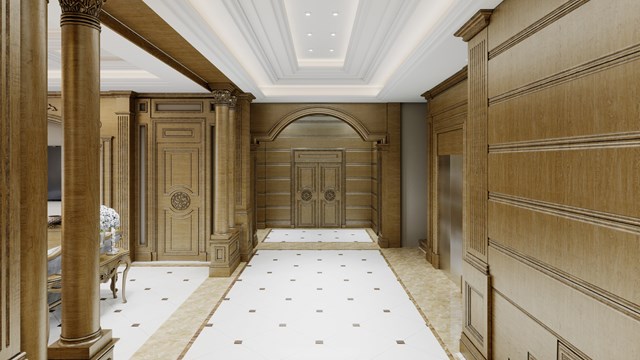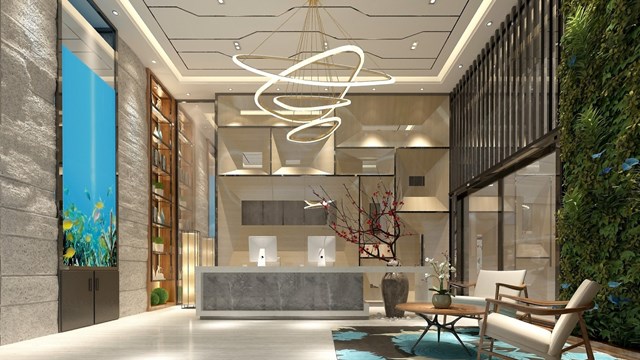
Asian-inspired design elements have been quietly infiltrating some of the swankiest New York dwellings - and with good reason. Actually two good reasons: form and function. The draw of the popular Asian aesthetic is that it cherishes both equally, and the results are often stunningly beautiful motifs that incorporate not only the practical and ergonomic needs of their users, but also their psychological, physiological and spiritual needs as well.
In a hectic city, this holistic approach to design has widespread appeal. After all, we New Yorkers are a savvy lot, expecting everything in our lives to multi-task. If we can demand that our water be infused with vitamins and our cell phones deliver stock quotes, why can't we expect our interior design to improve our moods and cultivate productivity? For discerning residents of luxury co-ops, attractive design alone just doesn't cut it anymore. But even if you don't want to head full-throttle into an Asian-looking theme, working in a few choice elements can greatly enhance the user-friendliness of your space - as well as the value of your property.
Borrowing Eastern aesthetics is hardly a new idea in the West. There have been several historic periods during which Western artists, architects and designers have drawn heavily on Eastern influence. In the mid 1800s, a movement known as Orientalism mined Middle Eastern themes. From the late 1800s to the 1930s, Art Nouveau, Art Deco, Modernism, and the Aesthetic movements all found inspiration in Asian art and design, particularly the pared-down Japanese styles that are still fueling Asian-inspired design today.
Along with the current yoga craze, the trend toward Zen-like interior design seems to stem from a craving for calm - a mainstay of Asian design principles. You may have noticed Zen-style stone gardens and indoor fountains springing up in atria and courtyards around Manhattan lately. Jade plants and raked sand may be enjoying a current vogue, but the underlying principles that give Eastern design its powerful effect run much deeper than such palpable emblems.
Even where it isn't necessarily obvious, there's often an undercurrent of Asian influence running through the design world. According to Rebecca Alston of Rebecca Alston, Inc., a Manhattan interior/architectural design firm, "What's really happening these days is a collision of ideas. There's been a wholesale revival of Modernism - which is really about simplicity, combined with renewed appreciation for natural materials, water elements and such. This Eastern influence is a very ethereal, environmental, even sacred approach to design. But it's not really new; many of the most important designers of this century - people like Frank Lloyd Wright, Walter Gropius and I.M. Pei - were always aware of it."
Creating a peaceful, attractive environment is the key to a welcoming residence. Whether you're planning on redecorating a courtyard, lobby or apartment, traditional Asian design techniques come to the rescue:
Simplicity: "My number-one tip is simplify," advises Alston. "An uncluttered space minimizes distraction. You don't have to strive for an impossible minimalism, but keep things streamlined."
To combat clutter and avoid over-decorating, consider favoring a few beautiful but functional objects instead of filling every corner of your space with extraneous bits and pieces. Look for clean lines and open spaces. Where possible, hide clutter in attractive storage features, like trunks, cupboards, and chests.
Materials: Natural materials are key. Elements of wood, stone, clay, bamboo, rice paper, and sisal can all create an organic feel that offsets harsh lines and warms up what could otherwise become a sterile space. "Pay close attention to textures," says Alston. "They become very important when you're working with neutral colors." For example, a nubbly fabric in a solid color adds interest without becoming frilly or overwrought. A sleek, lacquered box set atop a rough-hewn wooden table makes a nice contrast.
Color: Muted, natural colors are the basis of the home-as-sanctuary look, but don't be afraid to use brighter colors here and there. Just use them judiciously. A single bold color statement is usually enough - consider a solid scarlet area rug on a polished hardwood floor, or a spray of fresh flowers in a simple, unadorned vase - and don't forget that black can play a dramatic role in a neutral setting.
Water: According to Alston, water features are a hallmark of the Asian aesthetic. "People find it very soothing. Even a simple fountain - like a single bamboo stalk trickling one drop of water at a time - sets a meditative mood," she says.
Plants: Alston says gardens are also an important element. Whether you opt for a traditional rock garden or something more westernized, keep it manicured and simple. Using plants indoors creates a more fluid transition between indoors and out.
Lighting: Lighting should be used for a soothing effect, so fluorescents should be avoided at all costs. Recessed lighting works well to create a soft, indirect feel, and frosted glass, paper, or fabric shades help diffuse light and cast an attractive, warm glow. Bright, glaring lights make people squint and cast hard shadows, doing little to promote calm and relaxation.
Structure: Strong composition is essential. Look for bold, geometric forms. Keep things interesting by contrasting shapes (e.g. circular pillows on a boxy couch). Emphasize horizontal accents, which generate a strong sense of stability. For example, consider the impact of a long, low, rectangular dining table versus a high, round table with spindly legs and barstool chairs. Much of this decorating method is knowing intuitively what looks good and following a less-is-more approach to furnishing.
Despite its pop-culture co-opting, Feng Shui is more than just dragon-print wall hangings and tabletop fountains. Largely based on ideas like the art of object placement, Feng Shui may not necessarily result in an Asian-looking interior, but the psychological benefits are proving so successful that even the most skeptical amongst us are edging toward the bandwagon. "Lots of big corporations are calling in Feng Shui consultants, even banks like Republic National," Alston reports.
Champions of the ancient Chinese design method claim it promotes health, wealth, romance and fame. But even if you find it hard to swallow such lofty promises, don't be too quick to write the whole thing off as so much New Age hocus-pocus. At its heart, Feng Shui offers a sophisticated aesthetic that's rooted in creating a sense of balance, and thus, a low-stress environment. And while a peaceful abode or workplace may not guarantee a glowing complexion or a date with a movie star, it's certainly not a bad place to start.
Feng Shui literally translates to "wind water." Often called "acupuncture for the home," it is essentially the study of how energy (or chi) flows through a space. According to Stephanie Roberts, author of the Fast Feng Shui book series (and former co-op board president), chi should "meander through your home like a gentle breeze or a winding stream."
Where the free flow of chi is blocked, it is, says Roberts, "like a pond choked with algae," and can make you feel tired and depressed. Conversely, where chi flows too strongly, it is like a hurricane, causing anxiety and instability. Feng Shui uses shapes, colors, textures, sound, light, symbolic imagery and the arrangement of your furniture to adjust the energy of your home.
Roberts offers some simple suggestions on how to use Feng Shui in a common space, like the entrance or lobby of your building. "The main entry to a space is called the "˜mouth of chi.' This is a transitional area between public and private spaces. When you leave your apartment in the morning, it should gently assist you in gearing up for the day." Roberts recommends natural light, fresh air, trees, flowers, or possibly a fountain to act as "gentle indications that you are awake and emerging into the world."
In the evening, the same space can provide a calm oasis compared to the hustle and bustle of the street. A lobby can create some of this effect with artwork or a mural of a natural landscape, mirrors that brighten and enlarge the space. If your co-op or condo doesn't have a garden or courtyard, look for ways to use potted plants or fresh flowers in the lobby. "If that's not possible," says Roberts, "paint the walls a light, spring-like color."
Lighting is especially important too. "Public spaces nearest the street should be bright, airy and open. Hallways can have softer, somewhat lower light as a transition to private apartments. Residents can benefit, too, by having a well-lit entry or foyer in their own apartment."
Of course, you don't necessarily have to run out and put a Feng Shui master on retainer just to give the chi in your digs a boost. Type the words "Feng Shui" or "Asian Design" into any Internet search engine, and you'll be busy for the rest of the day sifting through troves of books, diagrams, tips, and online catalogs devoted to the practice and its various spin-offs. Web sites like www.wayofdesign.com are veritable galleries of ideas from all over the Far East, not only from China and Japan, but Burma, Thailand, and Indonesia, and other non-profit sites like www.fengshuisociety.org can help you navigate the forest of information. Your local bookstore or library are also good places to read up on how to arrange your living space to take full advantage of your home's natural chi-flow.
Keeping your property up to speed with the latest trends in design is a great way to boost the value and cache of your property. Luckily, the Western design world's Eastern gaze isn't likely to be filed under "What Were They Thinking?" a few years down the road alongside shag carpeting and beanbag chairs. Millions of people have known for centuries that it does matter where you put the sofa, and that the quality of light with which you surround yourself is important to both your mood and the mood of your home. Feng Shui and Asian design may be viewed as innovation on this side of the globe, but its longevity and simplicity have benefited generations of homeowners. n






Leave a Comment